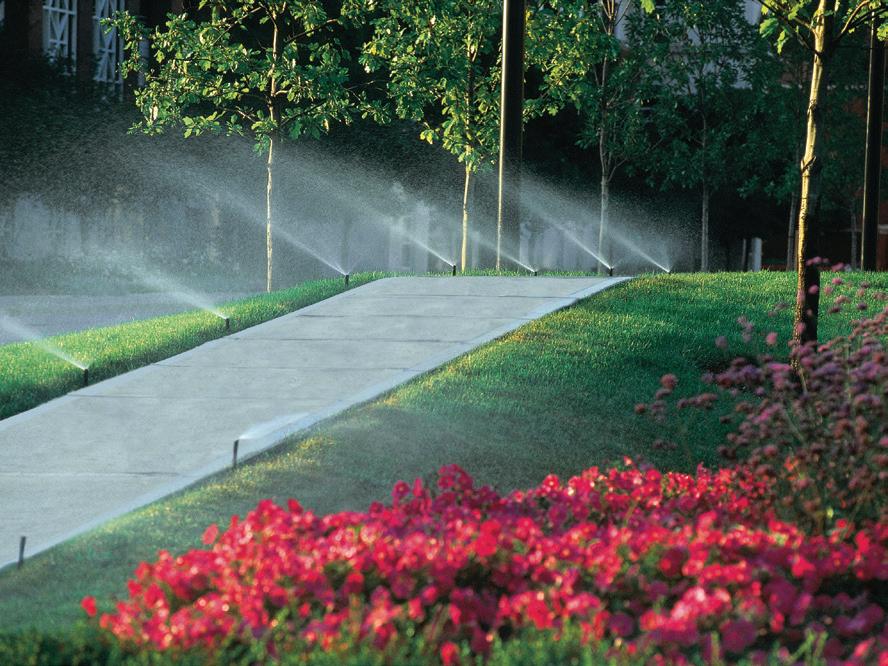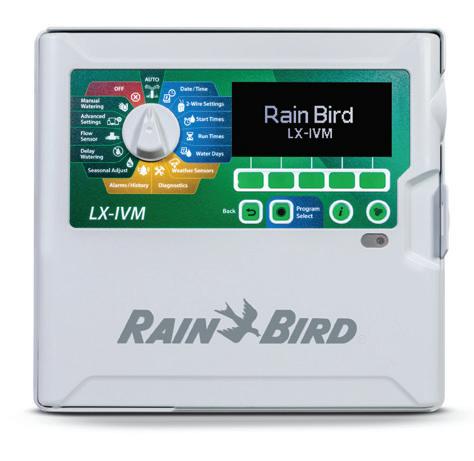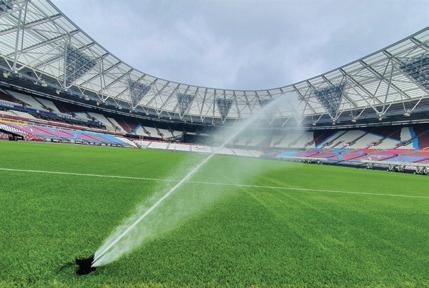
9 minute read
Irrigation
Water wise
Planning and maintaining landscape irrigation brings all round benefits says Peter Longman, Northern Europe Landscape Area Manager for Rain Bird Europe
Advertisement
Using an automated irrigation system is one of the best ways to keep new lawns and landscapes healthy whilst minimising water waste, keeping utility bills low and helping to protect the environment. In combination with up-front planning and professional advice, automated irrigation will help to ensure long-term satisfaction with any new residential or commercial landscape.
At the landscape and irrigation planning stage, working with a local qualified designer or contractor with knowledge of soil types and climate conditions will help greatly in the selection of appropriate turf and plant species. Grouping plants with similar watering needs close together and separating grassed areas from shrubs will assist in effective irrigation planning.
Irrigation zoning
Irrigation zoning is a process to be undertaken carefully, whilst also ensuring that the irrigation system will have enough capacity for now and the future. The more zones that are planned, the more irrigation can be customised to the installation, even if the landscaping is modified or extended at a later date. Installing extra connections at the outset makes it easier and less expensive to expand the irrigation system later.
Irrigation zones are areas that are watered by the same irrigation valve and delivery system, with irrigation scheduling taking into consideration sun, shade and wind exposure. However, the best system design will not perform as well as it should if inferior components
Smart Control

are selected or installed incorrectly. Checking on-site water pressure and the selection of the most appropriate sprinklers is essential as low or high water pressure can seriously affect their performance.
Something as simple as selecting the correct type of pipe can also mean the difference between a system that lasts and one that requires constant attention. Where surface or sub-surface dripline irrigation is installed, lines should be installed carefully to protect them from damage from aeration or other garden tools as well as other lawn or landscape maintenance procedures.
Smart controls
The inclusion of smart controls as part of an irrigation system will automatically adjust watering based on rain, soil moisture, evaporation and plant water use. Rain sensors will stop the system from operating when it does rain whilst a soil sensor measures moisture at the root zone and turns off the system when no additional water is needed.
In operation, water wastage can be avoided by setting sprinklers accurately to reach plants but not to soak an adjacent driveway, path or patio. Run-off can be reduced by watering each zone more often for shorter periods. For example, setting a system to run for three five-minute intervals lets the soil absorb more water than watering for 15 minutes at one time.
Scheduled watering
Watering at the right time of day is also important and the best times are late afternoon, evening, and just before sunrise. When the sun is low there is less wind and temperatures are lower, reducing evaporation by as much as 30 percent. Adjusting the watering schedule regularly to account for seasonal weather conditions and other factors will help to keep plants healthy without overwatering.
Irrigation systems need regular inspection and maintenance to keep them working efficiently year after year. Damage from lawn equipment or the effects of winter weather can cause leaks and other problems. Checking water pressure, examining for leaks, inspection of sprinkler heads and other components for damage should be routine, along with ensuring sprinkler heads remain set high enough to clear plants that may have grown taller since the system was installed.

It’s Your World.
Rain Bird offers the broadest range of easy-to-use controller solutions.
Explore our entire lineup at rainbird.com/TakeControl-en.
Irrigation rotors prove success
Launched in 2020 by Kar UK, the Hunter TTS-800 rotors are now one of the most soughtafter irrigation products in sportsturf. Sales manager Mike McDonnell reveals why
“Greenkeepers, course managers, grounds persons, stadium mangers and sports turf managers in general have a very difficult job when it comes to irrigation management,” explains Mike. “Playability can directly impact revenue and so effective irrigation is critical at all times.
Harsh environments and dirty water can complicate matters further. Turf Managers can push past such obstacles with TTS rotors. heavy duty, highly efficient easy to service – to ensure beautiful, playable pitches and courses for years to come.
“We have been delighted to see such interest in the TTS-800 series in the past year.”
As Mike says, the TTS-800 series are now relied upon at some of the most prestigious sporting venues in the UK and beyond. They integrate advanced technology with unrivalled power, reliability, and performance to simplify irrigation management and cultivate impeccable playing surfaces in every application.
TTS-800 rotors combine the field-proven benefits of Hunters’ robust, highly efficient G-80 and G-85 gear drives with an all-new Total-Top-Service body, inlet valve, and control mechanism to ensure unmatched ease of installation and serviceability.
“These really are the most reliable and powerful rotors in the industry,” continued Mike. “Our customers have been quick to praise Hunter’s patented TTS (Total-TopService) technology which allows for every serviceable element of the rotor to be accessed through the top.
Mechanical and electrical, big and small, operators can get to every component without disturbing the playing surface.
“This means there’s no more digging, no more unsightly scars, and perhaps more importantly, it is one less item on a busy turf manager’s schedule.”
Other benefits of the TTS series include: • Exclusive pressure port nozzle technology which maximizes distribution uniformity for healthy, playable turf in any setting. • The high-torque gear drive is the strongest in the industry to mitigate the challenges of reclaimed water and debris infiltration. • The TTS-800 Series are available in four models to ensure optimised performance in a range of applications. • A threaded inlet which sets the industry standard with heavy duty impact-resistant construction. • Three ports of entry are available – to allow for fast, organised, and easy wire management during installation. • The regulator is adjustable when installed or removed, allowing for easy fine-tuning of settings for optimal performance. • The on-off/auto-selector is colour coded with a visual indicator which makes it easy to identify when the rotor is in the manual off position. • A stage two filter protection helps prevent rotor weeping. • The powerful patented planetary gear drive powers through even the harshest conditions. • A range of nozzle packages are available with flows from 33.71 litres per minute at a radius of 11.3m to 225.6 litres per minute at a radius of 29.5m • Speciality low angle nozzles are also available to accommodate high-wind environments and other specific needs.
“A lot of research has been carried out over the years and it is not a surprise to see that Hunter systems offer 17% savings in water usage over the competition on average,” says Mike


Green to go!
Landscapers spend a huge amount of time looking after easier and quicker, saving time and money. and keeping green surfaces green. This year, with lock Nonanoic acid also has the benefit of working very down and limited footfall, many other areas of the urban quickly even under poor conditions. The site below was landscape have also become green having been infested sprayed at the end of October in dull damp conditions with algae and moss. The damp conditions at this time and the speed of activity from Nonanoic acid (Enclean) of year encourage these organisms and make facilities can be clearly seen. look unkempt. Many different areas are affected; pathways, patios, car parks, patios, street furniture and signs, railings, wooden structures and artificial grass are particularly vulnerable.
Hopefully we are getting nearer to opening facilities that attract the public so now is the time to de-green these surfaces so they look good for when the public return.
To keep staff and the public safe on these hard surface areas, this unwanted greenery needs to be degreened to reduce the risk of: • Slips and falls. • Areas freezing and becoming very slippery. • Damage to surfaces by invasive species, due to water ingress. • Areas looking unkempt, with invasion of green simple organisms including moss
With the large number of product brands, users need to carefully check the concentration of the active ingredients in the formulations. These vary from 4.8% up to 40%. The literature and label recommendations for use are often not very clear. Sometimes they make claims, which are different to the label recommendations and the registered dose and application area per pack. The registration can be checked on the HSE Biocide database.
Many products sold for this all need similar conditions to perform effectively. They all need large volumes of concentrated product, circa 100 to 200 litres of product. This needs to be applied in about 1,000 to 2,000 litres Wood shed untreated Wood shed treated with of spray per Ha. Hence a 15l knapsack will only treat Enclean after 25 days’ about 40-80 square metres of hard surface per fill. These products also require a 24 hour drying cycle post application to work effectively. Recently Nonanoic acid has received UK BPR approval for use as a hard surface biocide and marketed by Rigby Taylor Ltd as Enclean (500g/l nonanioc acid) The product is a naturally derived ingredient extracted from sunflower and oilseed rape meal. Applied at 18.5 l/ha, just 1 litre of Enclean plus 14 litres of water mixed in a 15l knapsack will treat 555 square metres using a 85 1 litre pack degree red even spray nozzle. Pavement treated with Enclean of Enclean This makes application much - untreated centre strip

Untreated and treated block paving
Enclean can be used in many places: Patios, tarmac, artificial surfaces, roofs, netting, car parks, paths around buildings, block paving, fire exits, fencing, any wooden structures on course, patios, signage. Used correctly,
Enclean can be an invaluable management tool to achieve good looking and safe facilities. Now is an ideal time to start your degreening programme with Enclean, so your facilities look impressive when the public return.
The path below was sprayed, in the wet, a day before the recent freezing weather. Picture show show effective Enclean is, even under very poor conditions. Enclean is produced from plant origins, so it is a sustainable biocide that is not produced from fossil fuels. Applications can be made under wide range of conditions and works within 48 hours irrelevant of temperature. Contact Rigby Taylor for more information on the latest biocides.










